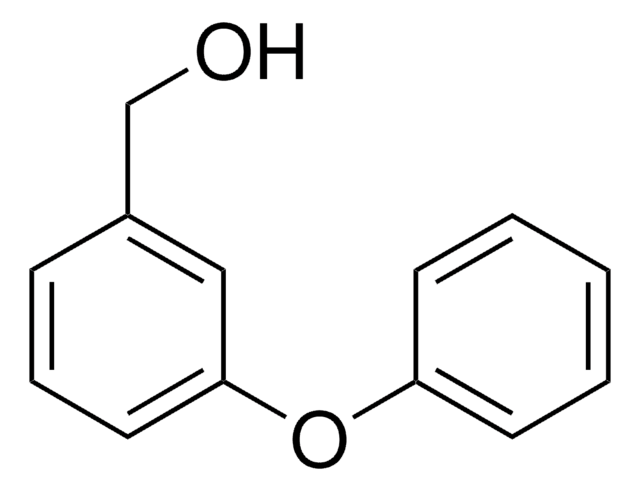188212
3-Methylbenzyl alcohol
98%
Se connecterpour consulter vos tarifs contractuels et ceux de votre entreprise/organisme
About This Item
Formule linéaire :
CH3C6H4CH2OH
Numéro CAS:
Poids moléculaire :
122.16
Numéro CE :
Numéro MDL:
Code UNSPSC :
12352100
ID de substance PubChem :
Nomenclature NACRES :
NA.22
Produits recommandés
Essai
98%
Forme
liquid
Indice de réfraction
n20/D 1.534 (lit.)
pb
215 °C/740 mmHg (lit.)
Densité
1.015 g/mL at 25 °C (lit.)
Chaîne SMILES
Cc1cccc(CO)c1
InChI
1S/C8H10O/c1-7-3-2-4-8(5-7)6-9/h2-5,9H,6H2,1H3
Clé InChI
JJCKHVUTVOPLBV-UHFFFAOYSA-N
Description générale
3-Methylbenzyl alcohol participates in gas phase hydrogenation of methanolic solutions of isophthaldehyde over a Ni/SiO2 catalyst.
Code de la classe de stockage
10 - Combustible liquids
Classe de danger pour l'eau (WGK)
WGK 3
Point d'éclair (°F)
222.8 °F - closed cup
Point d'éclair (°C)
106.00 °C - closed cup
Équipement de protection individuelle
Eyeshields, Gloves
Faites votre choix parmi les versions les plus récentes :
Déjà en possession de ce produit ?
Retrouvez la documentation relative aux produits que vous avez récemment achetés dans la Bibliothèque de documents.
Les clients ont également consulté
Gas phase hydrogenation/hydrogenolysis of isophthaldehyde over Ni/SiO2.
Keane MA.
Bull. Soc. Chim. Belg., 104(2), 63-67 (1995)
Production of ligninolytic enzymes of the white rot fungus Panus tigrinus.
Leontievsky AA, et al.
Journal of Biotechnology, 32(3), 299-307 (1994)
Chun Chau Sze et al.
Journal of bacteriology, 184(3), 760-770 (2002-01-16)
Pseudomonas-derived regulators DmpR and XylR are structurally and mechanistically related sigma(54)-dependent activators that control transcription of genes involved in catabolism of aromatic compounds. The binding of distinct sets of aromatic effectors to these regulatory proteins results in release of a
S Fraile et al.
Journal of bacteriology, 183(19), 5571-5579 (2001-09-07)
We have isolated a recombinant phage antibody (Phab) that binds a distinct epitope of the subclass of the sigma(54)-dependent prokaryotic enhancer-binding proteins that respond directly to aromatic effectors, e.g., those that activate biodegradative operons of Pseudomonas spp. The DNA segments
Anu Vaidyanathan et al.
Journal of toxicology and environmental health. Part A, 66(12), 1133-1143 (2003-06-07)
Xylene is used as a solvent in paints, cleaning agents, and gasoline. Exposure occurs primarily by inhalation. The volatility and lipophilicity of the xylenes make the lung and nasal mucosa the primary target organs. m-Xylene (m-XYL) has been shown to
Notre équipe de scientifiques dispose d'une expérience dans tous les secteurs de la recherche, notamment en sciences de la vie, science des matériaux, synthèse chimique, chromatographie, analyse et dans de nombreux autres domaines..
Contacter notre Service technique










